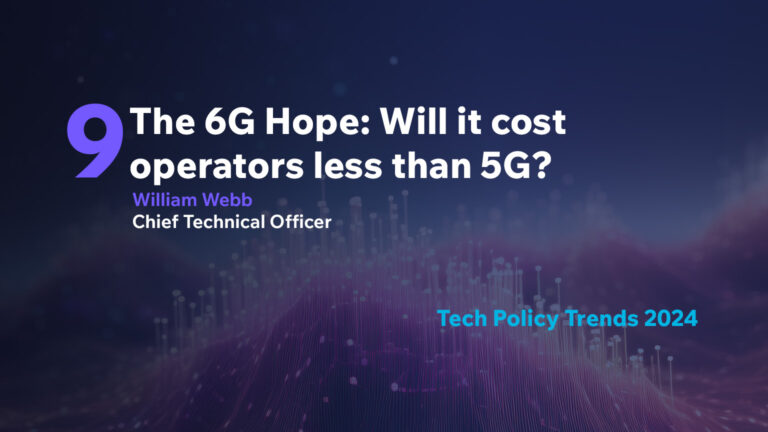Predicting the arrival of 6G seemed like an easy task based on previous generations of mobile phone technology, but with efficiency improvements and demand starting to plateau, how will 2024 shape the landscape for the next decade?
current situation
2024 may seem like a little early to be talking about 6G, given that its predecessors still feel like relatively new services. But it’s been five years since the first 5G deployments began service in 2018 in major countries, meaning 5G is more of a mature technology than a new concept. 5G will continue to evolve, but attention is now turning to its successors.
Back in 2022, it would have been fairly easy to predict the arrival of 6G. Each generation of cellular technology has been roughly 10 times faster than the previous one, with 10 times the capacity, and arriving 10 years later. Based on this, 6G is expected to be widely deployed around 2030, with average data rates of around 2 Gbps.
But over the past year or so, there has been a growing realization that the 5G vision was flawed. 5G’s high data rates have not yet opened up new applications or revenue streams for mobile operators, and its complexity and use of high frequency bands required heavy capital investment. Mobile operators are now cutting back on network investments, with many of the biggest names in the market, including Ericsson, now Huawei, and Huawei, now Huawei.
Nokia has announced major cost-cutting measures but is now struggling as a result.
Last year also revealed that mobile data growth is slowing. Instead of expanding 50-60% per year, data rates are now growing at around 20-30% per year. Logically, this decline will continue unless a new factor emerges. This is because the largest driver of data usage to date has been video, and consumers only want to watch video on their phones for a limited amount of time per day. As more users approach this limit, the overall growth in mobile data usage will slow. This means that data usage may plateau by 2030, and capacity increases will no longer be a key factor for 6G.
These trends have raised questions about whether 6G will be 10 times faster, and whether it will be available as soon as 2030. Mobile operators have been much more vocal than in the formative days of 5G, widely stating that they want 6G to be just a software update and not require new network equipment, and this is especially true for base stations.
As the deployment of dense networks requires more base stations and costs rise, mobile operators are more interested in features that reduce costs than those that offer a wider range of features to consumers. As a result, operators are in no rush to welcome 6G, preferring to wait until the 2030s.
That said, mobile operators generally do not play a leading role in developing mobile standards; equipment manufacturers drive this process.
Delivering 6G early without the need for hardware replacement will increase revenue. Similarly, manufacturers are realizing that developing solutions that exceed customer requirements could hurt sales.
6G is still a long way off, but the next few years will determine the direction of standards and ultimately solidify what form 6G will take.
The big question
A key question for 6G is whether the “10x vision” or the “software-only” vision will come to fruition. In reality, the standard is full of compromises and options and may contain elements of both. So the question is which direction the standard will lean.
This decision is heavily influenced by three factors:
- whether mobile data growth will continue to slow;
- Will new applications emerge that require 5G?
- Geopolitics and national incentives.
Behind this lies an even bigger uncertainty: the future of mobile operators and industry suppliers. For example, a software-only future indicates limited growth potential and a trend towards the industry becoming more utility-like.
Because 6G is still more than six years away, 2024 forecasts should include leading indicators rather than hard data such as the number of 6G base stations sold.
Based on these leading indicators, we predict:
1. Mobile data growth will be around 3-5% lower per year in 2024 than in 2023 (i.e., a 25% growth rate could fall to 20-22%).
2. No significant new 5G applications will emerge.
3. There will be more reports of cost cutting by mobile operators than network enhancements and 5G expansion.
Our prediction for 6G is that the “software-only” vision will dominate sometime in 2024. This is very hard to measure directly, but one indication is that there is less press interest in 6G because the vision itself is less interesting to journalists. This is the opposite of the usual trend of more and more mentions as the concept develops and the launch date gradually approaches.
Other indicators include the level of interest in “10x features” versus “software-only” features. For example, one of the key areas for 10x 6G is the use of THz frequencies – bands above 100 GHz that have great capacity but very limited range. To make this more usable, there is active research into intelligent reflective surfaces that can bounce signals around obstacles.
Conversely, an area of greater interest for software-only 6G is the potential use of AI to optimise networks and provide more capacity from existing resources.We expect to see less interest in THz and related technologies in 2024 and more excitement around the use of AI and more (although to some extent this may reflect a general increase in interest in AI).
While 2024 isn’t definitive when it comes to 6G, the next 12 months will likely reveal more about what 6G will look like and when it will arrive.


